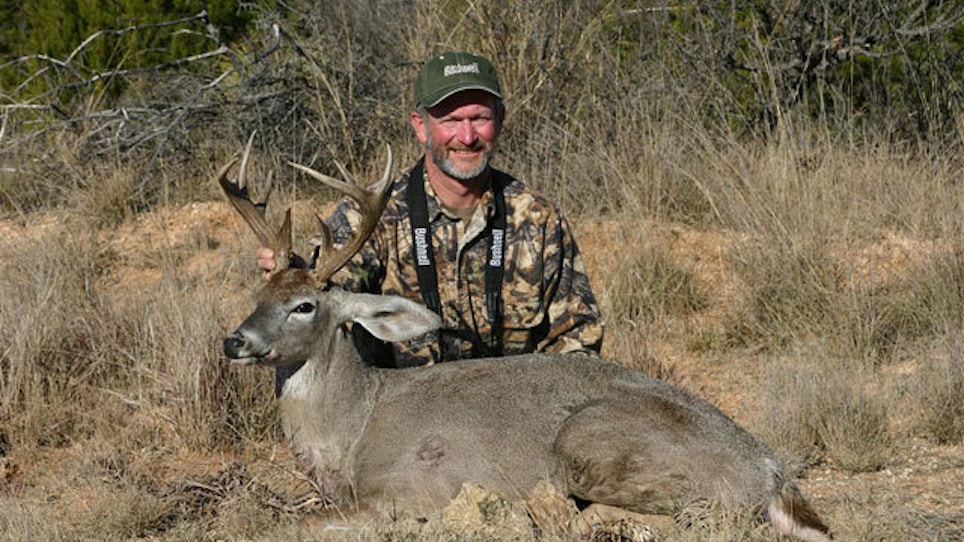Winter doldrums got you down? Had enough of bad weather, short days, and no deer hunting for way too many months? Like to try new things, see new places, do some hunting unlike anything you’ve tried before?
If that’s the case, here’s an adventure you will never forget. One caveat, however — the hunting can be so good, you might find yourself needing to come again.
I am talking about heading south of the border to the Mexican state of Coahuila, located south of Texas, and hunting a relatively obscure whitetail subspecies, the Carmen Mountain whitetail (Odocoileus virginianus carminis) — a diminutive deer that reminds me a lot of my all-time favorite Western deer, the Coues whitetail. It’s one that few hunters ever specifically target — or even know about.
The name is derived from the Carmen Mountains in the northern Mexican state of Coahuila. Collectively they are found from the Chisos Mountains (an extension of the Carmen Mountains) in Big Bend National Park in Texas, southward in all the mountain ranges of north central Coahuila as far as the San Marcos Mountains south of Cuatro Ciénegas. In West Texas, the Carmen Mountain whitetail population is relatively stable and occurs in several mountain ranges in southern Brewster and western Presidio counties. The primary habitat of this little whitetail subspecies is the pinion-juniper-oak associations of the Chisos Mountains. Among biologists there is some debate concerning the whitetail subspecies living in the Davis Mountains at higher elevations and whether or not they are the Carmen subspecies, the more common Texas whitetail deer, or perhaps an intergrade of the two; however, this population is relatively stable in areas with abundant woody cover and free-standing water. Also, comparisons of cranial measurements among Texas whitetails (O. v. texanus), Coues deer and Carmen Mountain whitetails have shown that deer from the Rosillos, Christmas, Chinati and Davis mountains in the Trans-Pecos region should be referred to as carminis. This assignment extends the range of carminis between 190 and 200 kilometers to the north and northwest into Jeff Davis and Presidio counties.
These deer are a mountain type subspecies of whitetail deer, in size somewhat smaller than the Coues deer, with the coloration and markings typical of the species, though they do have a disproportionately large, flashy tail. The antlers are generally shaped like a rather typical yet compact whitetail rack, with tines varying in length and mass. Like Coues deer, they are secretive and quite elusive. For recordkeeping purposes, Safari Club International recognizes the Carmen Mountain subspecies, but the Boone and Crockett and Pope and Young clubs do not.
My experience hunting carminis has been confined to Coahuila on a hunt arranged a few years ago by my booking agent buddy, Wade Derby of Crosshair Consulting (925-679-9232), and it was one of the most memorable Western deer hunting trips I have ever taken. The 40,000-acre ranch we hunted was absolutely loaded with deer, and high-quality bucks were quite abundant, thanks in no small part to the extremely limited hunting pressure and pride in the wildlife shown by the owners.
The ranch owners keep meticulous records of all the deer taken on their property. In fact, each year they conduct their own deer census and keep records that would make most American game departments proud. In addition, every deer that is taken on the ranch is first field-dressed, then weighed, and their antlers scored using the Safari Club International scoring system. The records are then entered into a computer spreadsheet program; they have detailed records going back more than a decade.
Their records show that the average weight over a six-year span is 95.6 pounds (field-dressed), and 82 percent of the harvested deer had typical racks. Of the non-typicals, 16 percent had from 4 to 7 points, 54 percent 8 points, 15 percent 9 points, 10 percent 10 points and 5 percent more than 10 points. The average buck taken on this ranch is an 8-pointer that scores approximately 105 SCI points. Hunting occurs from mid-December through January, with the rut peaking in early to mid-January.
On this hunt the results were breathtaking. One buck, a non-typical brute taken by California hunter Richard “Doc” Brophy, scored an incredible 129 3/8 Safari Club International (SCI) points. In all, eight of the nine bucks we shot scored over 100 SCI points, with six of them scoring over 110 SCI points. This might not seem like big numbers to some, but I am here to tell you when you are talking about hunting the Coues deer-like Carmen Mountain whitetail, it just doesn’t get any better.
Guided hunting is also available in Texas, Derby said, with success rates high, though the trophy quality is generally a bit higher on average south of the border. One outfitter with a solid track record of success is Steve Jones of Backcountry Hunts.
Generally speaking, Carmen Mountain whitetails are found at elevations above 4500 feet. Spot-and-stalk hunting is the ticket, though at times setting stands or ground blinds over water can work well. These deer are masters of the disappearing act. Their brown summer and gray winter coats are perfect for matching the terrain in which they live, and given their diminutive size, it is easy for them to hide behind the smallest bush. On top of this, they are scared of their own shadows and will quickly get out of Dodge if they even think something is amiss.
Any flat-shooting caliber from the .243 through the various .300 magnums will get it done. A good 10X binocular and spotting scope in the 15-45X or 20-60X class with sturdy tripod will make finding and evaluating deer possible at extended ranges. I also always bring along a quality laser rangefinder and a daypack large enough to carry plenty of water.
How much do I like this hunt? I am already booked on a Coahuila hunt this January — and I can’t wait.






